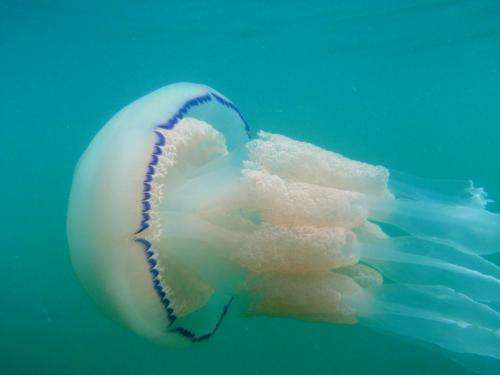Barrel jellyfish. Credit: Graeme Hays
Jellyfish might look like mere drifters, but some of them have a remarkable ability to detect the direction of ocean currents and to swim strongly against them, according to new evidence in free-ranging barrel-jellyfish reported in the Cell Press journal Current Biology on January 22.
"Detecting ocean currents without fixed visual reference points is thought to be close to impossible and is not seen, for example, in lots of migrating vertebrates including birds and turtles," says Graeme Hays of Deakin University in Australia.
"Jellyfish are not just bags of jelly drifting passively in the oceans," he adds. "They are incredibly advanced in their orientation abilities."
The researchers tracked the movements of the jellyfish with GPS loggers and used GPS-tracked floats to record the current flows. They also directly observed the swimming direction of large numbers of jellyfish at the surface of the ocean.
The data show that jellyfish can actively swim at counter-current in response to drift, the researchers report. Their model of the jellyfishes' behavior, together with ocean currents, helps to explain how jellyfish are able to form blooms including hundreds to millions of individuals for periods up to several months.
It's not yet clear exactly how the jellyfish figure out which way to go. Fossette and Hays say it's possible that the animals detect current shear across their body surface, or they may indirectly assess the direction of drift using other cues, such as the Earth's magnetic field or infrasound.
Understanding the distribution of jellyfish in the open ocean may be practically useful for predicting and avoiding troublesome jellyfish blooms, especially if it turns out that the findings in barrel-jellyfish apply to other species. While jellyfish do play an important role in ocean ecosystems as prey for leatherback sea turtles and other animals, Hays notes, they can also clog fishing nets and sting beachgoers.
Tagged jellyfish in motion. Credit: Graeme Hays
"Now that we have shown this remarkable behavior by one species, we need to see how broadly it applies to other species of jellyfish," Hays says. "This will allow improved management of jellyfish blooms."
More information: Current Biology, Fossette et al.: "Current-oriented swimming by jellyfish and its role in bloom maintenance" www.cell.com/current-biology/a … 0960-9822(14)01544-9
Journal information: Current Biology
Provided by Cell Press























